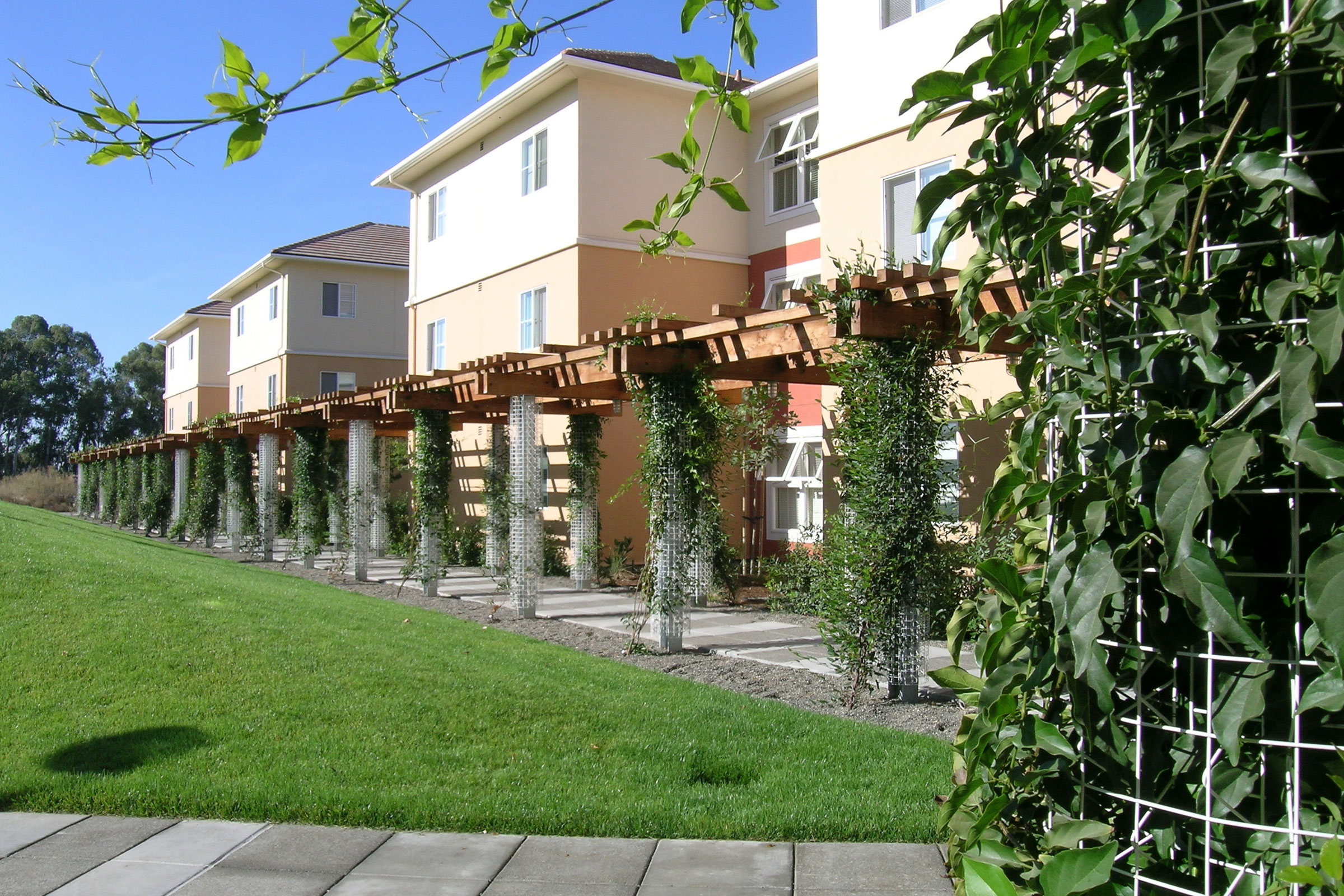Story at a glance:
- The green design process begins with careful consideration of the site’s climate.
- By considering the intended purpose, climate considerations, plant morphology, and budget, you can select the most suitable plants for your green design project.
Green design, also known as sustainable design, is an approach that aims to create environmentally friendly and healthy spaces with a positive impact on the environment and human health. It involves designing buildings, landscapes, and other areas to reduce energy consumption, pollution, and waste generation.
Starting Your Green Design Process
Designing outdoor green spaces requires careful consideration of the site’s climate. Factors like plant species, irrigation systems, and maintenance requirements should be adjusted to ensure a high-quality landscape.
It is recommended to conduct onsite research and analyze similar projects to understand what works best in a specific climate. It’s important to note that the climate can vary significantly between ground level and the rooftop of a skyscraper, so both horizontal and vertical climate variations should be considered. This is particularly important when it comes to green roofs.
Before beginning the design phase, it is essential to consider the architectural context of the site, including the building’s location as it relates to sun exposure and shade. The impact of sunlight throughout different seasons should be thoroughly evaluated, and plants should be selected according to the gathered data.
Plant Characteristics Affect Green Design Choices

Chesterfield Square in South LA. Photo courtesy of Greenscreen
It is imperative to consider plant characteristics to develop a robust and sustainable green design solution. It is worth noting that each plant is uniquely adapted to specific conditions, necessitating the selection of suitable plants based on different climates. Instead of working against these natural adaptations, it is wiser to leverage them.
Planting unsuitable vegetation in inappropriate spaces can result in costly maintenance demands like expensive irrigation. Some plants may deteriorate rapidly in wet conditions, while others may struggle to survive in dry environments.
Moreover, the choice of plants depends on the purpose of the green solution. Are you aiming to create a biodiverse and cooling trellis system for a building? Or is your objective to maximize rain capture through a green roof? Perhaps your goal is to trap air pollutants with a green wall? By considering the intended purpose, climate considerations, plant morphology, and budget, you can make informed decisions when selecting the most suitable plants for your green design project. This approach ensures resilience and can minimize maintenance requirements.
Water and Gas Exchange in Plants
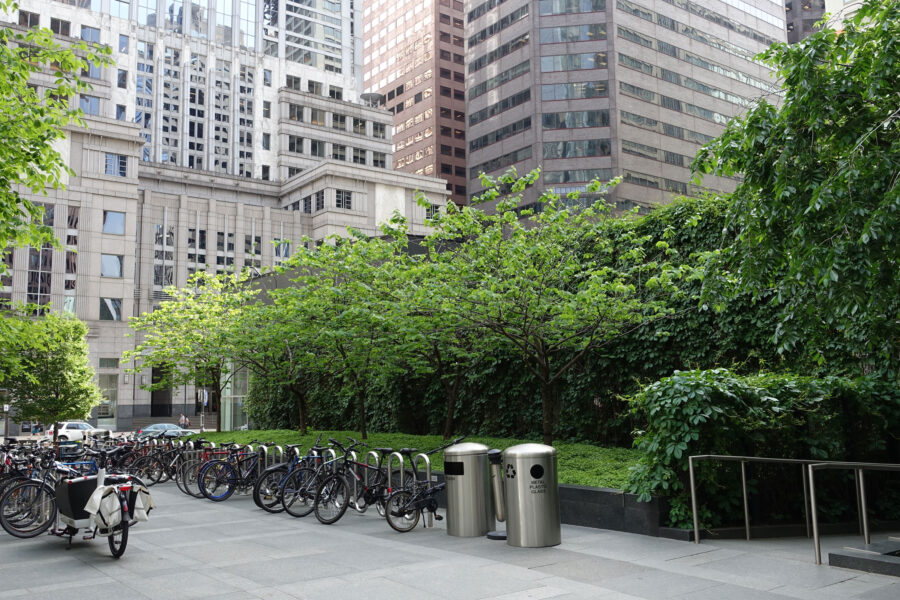
Comcast Plaza in Philadelphia. Photo courtesy of Greenscreen
Water and gas exchange in plants are essential for plant growth and survival. Evapotranspiration refers to the movement of water from the land surface to the atmosphere through evaporation and transpiration processes. This includes water evaporation from the soil surface, capillary fringe of the groundwater table, and water bodies on land. It also includes transpiration, which involves three steps—roots extracting water from the soil, water flowing through plant tissues for essential functions, and leaves expelling water vapor through pores on their surface called stomata.
Although transpiration is not easily visible, it is a significant process responsible for, on average, 95 to 99% of the water taken up by plants. During a growing season a leaf can transpire a large amount of water compared to its weight. For example, an acre of corn releases about 3,000 to 4,000 gallons of water daily, and a large oak tree can transpire 40,000 gallons annually.
Transpiration Rates in Plants
The rate of transpiration can be influenced by various factors, including:
Type of plant: Different plant species have varying rates of water transpiration. For example, desert plants like cacti and succulents have evolved to conserve water by transpiring less than other plants.
Precipitation: Dry periods can lead to moisture depletion in the upper layers of soil, impacting vegetation and agricultural fields where crops are grown.
Sunlight availability and intensity: The amount and intensity of sunlight influence transpiration. During the growing season, when sunlight is stronger and air temperatures are warmer, transpiration rates increase.
Temperature: Warmer temperatures promote higher transpiration rates, as they cause the plant cells responsible for opening and closing stomata (pores) to release water into the atmosphere. Cooler temperatures, on the other hand, cause stomata to close.
Soil type and saturation: The composition of the soil plays a role in transpiration. Clay particles being small retain water, while sand which has larger particles release water more easily. In times of water scarcity, plants may undergo premature aging and transpire less water.
Humidity: Transpiration rates are affected by the relative humidity of the surrounding air. Higher levels of humidity result in reduced transpiration, as water evaporates more easily in drier air.
Wind and air movement: Increased air movement around plants accelerates transpiration. Wind replaces the saturated air surrounding the leaves with drier air, leading to higher water loss rates.
Land slope: The slope of the land can also affect transpiration, although the specific mechanisms and impacts may vary.
Understanding these factors can help manage and optimize transpiration rates in various plant environments and agricultural settings.
Morphological Adaptations to Light and Water
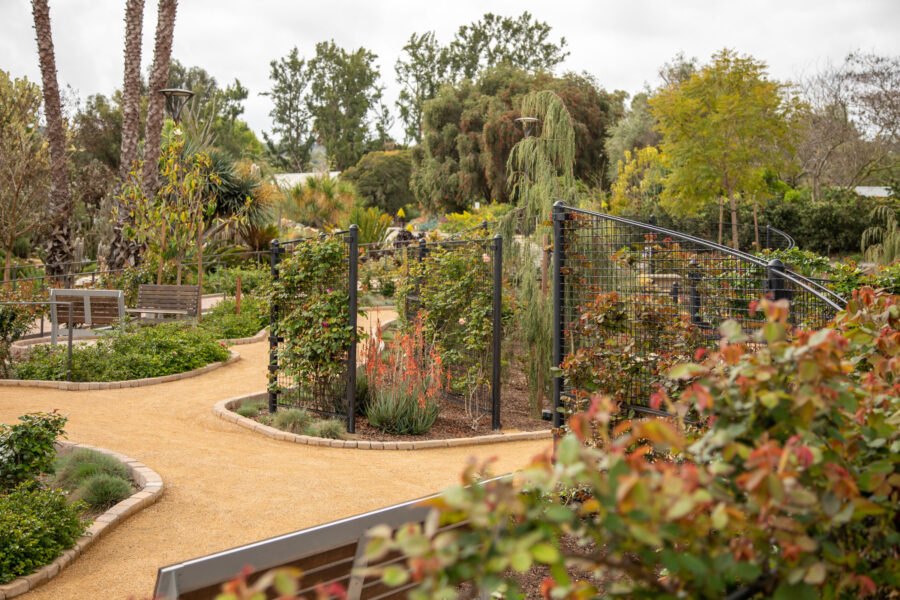
South Coast Botanic Garden in Palos Verdes Peninsula, California. Photo courtesy of Greenscreen
Plants in arid regions have developed various strategies to survive droughts by conserving water. These adaptations include shedding leaves, reducing leaf size and number, limiting branching, and developing hard leaves that can withstand wilting.
Some plants in dry environments have even evolved smaller leaves with fewer stomata and may shed their leaves entirely during droughts to minimize water loss. Another way for plants to endure droughts is through sclerophylly. This is where plants develop stiff leaves that are not easily damaged by wilting and can regain full functionality once normal conditions return. Examples are laurel (Laurus nobilis), holm oak (Quercus ilex), wild olive (Olea europaea), myrtle (Myrtus communis), and strawberry tree (Arbutus unedo).
A general rule is that fewer leaves result in less water loss due to transpiration.
The root system of most plants is the first to react to drought, with lateral root growth being significantly affected while the primary root often remains unaffected.
Xerophytes: Dry-Adapted Plants
Plants that thrive in arid environments possess remarkable adaptations to minimize transpiration rates. These adaptations include a thick waxy cuticle, which acts as a dual-purpose barrier by reducing evaporation and reflecting heat due to its shiny surface. Some plants have sunken stomata found in pits within the epidermis, which trap moist air, effectively elongating the diffusion pathway and reducing evaporation.
Another adaptation is the presence of rolled leaves with stomata positioned inside, along with fine hairs that aid in trapping moist air, consequently decreasing transpiration. The rolled leaf structure not only minimizes the drying effect of wind but also exposes a smaller leaf surface area to evaporation.
Several xerophytic plants opt for small, needle-shaped, or circular leaves, thus further reducing the evaporating surface. Spines serve multiple purposes, such as protecting the plant from animals, providing shade from the sun, and even collecting moisture. Moreover, these drought-resistant plants develop extensive shallow root systems that are often circular in shape, facilitating rapid water absorption during rainfall events.
Hydrophytes: Wet-Adapted Plants
Plant adaptations for wet conditions optimize absorption and photosynthesis by utilizing submerged leaves with a high degree of dissection or division. These specialized leaves lack a protective layer and stomata on the undersides, allowing for direct absorption of water, nutrients, and gases from the surrounding water.
Chloroplasts are concentrated in the well-lit upper leaf surface. In wetland plants, air enters the internal gas spaces of young leaves at the water’s surface and travels down through their hollow stems to the roots, while older leaves release gas from the roots.
Hydrophytes’ stems and leafstalks have minimal or no mechanical strengthening tissue, resulting in limpness when removed from water. However, this lack of mechanical support allows for flexibility in response to water level changes or movements.
In wetland plants roots are often reduced in size and primarily serve as an anchoring function. Absorptive root hairs may be absent, and in some cases, the roots may not be present at all. Under flooded conditions, certain herbaceous and woody species experience rapid shoot growth allowing the shoots to reach above the water’s surface to facilitate gas exchange.
Don’t Forget the Light
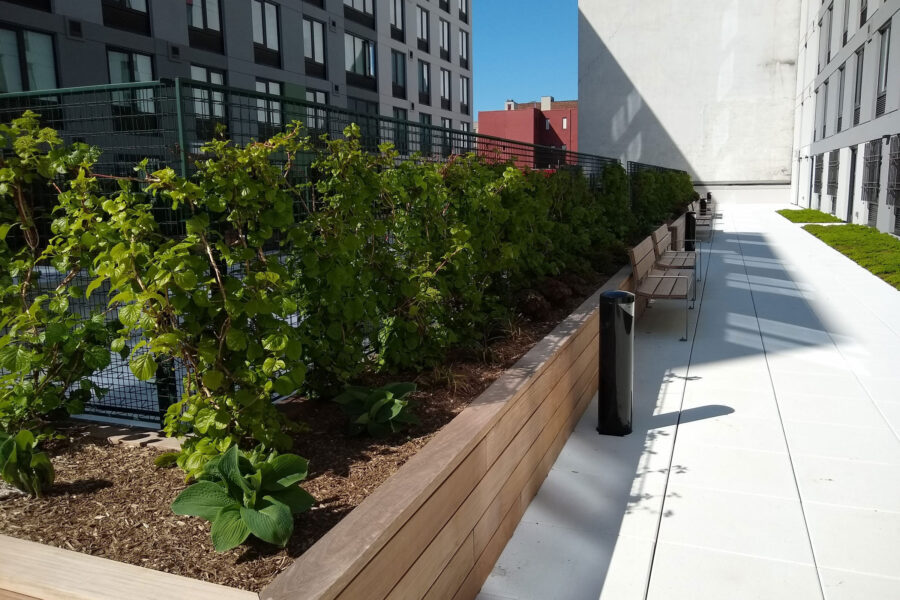
The Wilfrid in the Bronx. Photo courtesy of greenscreen
Sunlight plays a vital role in the growth of plants through photosynthesis. The amount of sunlight received affects the rate of growth and overall health of plants. Some thrive in full sun, while others prefer partial or complete shade. Additionally, factors like location, season, and time of day also play a significant role in determining the amount of light exposure.
When designing outdoor green projects, it is essential to consider how plant leaves adapt to light or shade, as it can significantly influence the overall outcome. Optimal indoor plant growth can be achieved by strategically placing plants near skylights or windows to maximize natural light. In areas with limited natural light, the use of artificial grow lights can be beneficial. These lights simulate the sun’s role and enable plants to thrive in darker areas.
A plant’s structural adaptation is crucial for its survival in various environments. Some species have specialized structures that allow them to withstand extreme conditions, such as cold or heat. Climbing plants employ tendrils and roots to reach higher for optimum sunlight and water absorption. In contrast, crawling or ground-level species tend to remain closer to the ground to access essential soil nutrients.
When designing a landscape it’s important to strike a balance between shade-tolerant and sun-loving plants. This directly impacts the amount of natural light each species receives, which in turn influences their growth rates and overall health. Shade-tolerant varieties can tolerate less direct sunlight but require intermittent exposure to ensure sufficient light without wilting or leaf burn. Therefore, cautious selection is necessary when deciding which plants to incorporate into your project.
Molecular Adaptations
As working professionals in the field of green buildings, you are no doubt familiar with the various plants you encounter in your designs. While you don’t need to be a scientist to appreciate their beauty and utility, understanding some fundamental molecular differences between specific plant types can help you make more informed choices in your projects.
In arid conditions, as a plant struggles to maintain a balance between photosynthesis and water loss, it must contend with harmful molecules known as free radicals. While free radicals are a natural byproduct of photosynthesis, their formation increases in water-scarce environments. These molecules pose a significant threat to cellular components such as DNA, cell membranes, proteins, and sugars—all vital for cell survival.
Plants have adapted to cope with limited quantities of free radicals. However, drought-tolerant plants excel in handling these molecules as they accumulate protective substances called free radical scavengers. These scavenger molecules often alter the plant’s color, with red or purple hues becoming visible. With their remarkable ability to neutralize free radicals, these scavengers serve as a defense mechanism, shielding the plant from potential harm.
Photosynthesis Adaptations to Drought
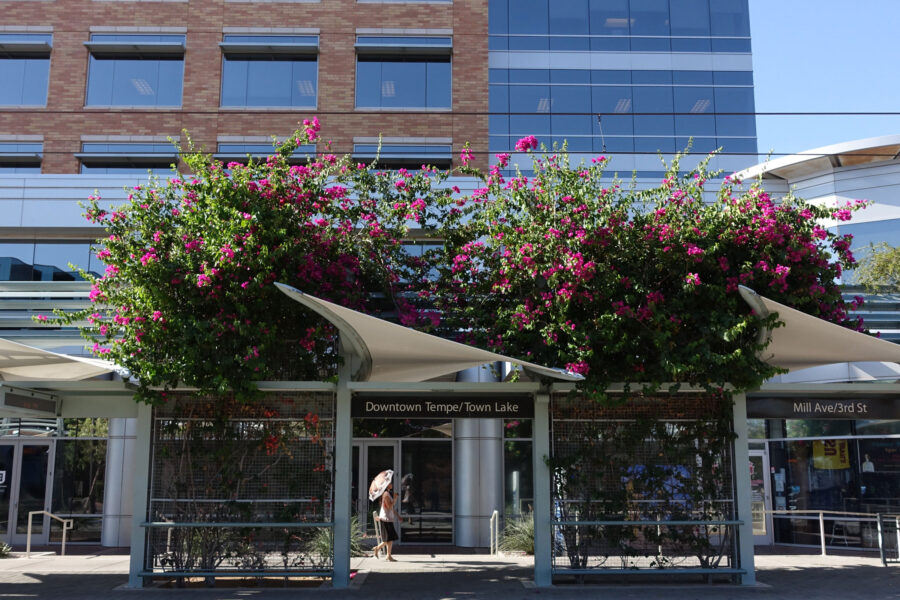
Valley Metro Rail in Phoenix. Photo courtesy of Greenscreen
C3 plants comprise most plant species, around 85%, and include several familiar faces, including roses, maples, and wheat.
C3 plants rely on something called C3 photosynthesis, where the crucial enzyme, RuBisCO, captures carbon dioxide from the atmosphere to initiate photosynthesis. This natural process is incredibly efficient in cooler climates and moderate sunlight. However, C3 plants face challenges in hot and dry conditions where their carbon fixation process becomes inefficient, resulting in a loss of energy through photorespiration. Additionally, these plants lose significant amounts of water in hot and arid climates as their stomata remain open during the hottest parts of the day.
C4 plants, on the other hand, exhibit a unique adaptation that helps them thrive in hot and sunny environments. Species like corn, sugarcane, and some grasses utilize C4 photosynthesis, which involves an additional step to concentrate carbon dioxide around the RuBisCO enzyme to minimize photorespiration. This process allows them to use less water while maintaining high photosynthetic rates, making them an ideal choice for landscaping projects in areas where water conservation is a priority.
CAM Plants: Masters of the Desert
Finally, CAM (Crassulacean Acid Metabolism) plants, like succulents and cacti, have developed a completely different approach to photosynthesis. These plants open their stomata at night and store carbon dioxide in the form of malate, a four-carbon compound. During the day when their stomata are closed, CAM plants utilize the stored carbon for photosynthesis. This unique adaptation allows them to conserve water in arid environments, making them an excellent choice for xeriscaping and water-wise garden designs.
Conclusion
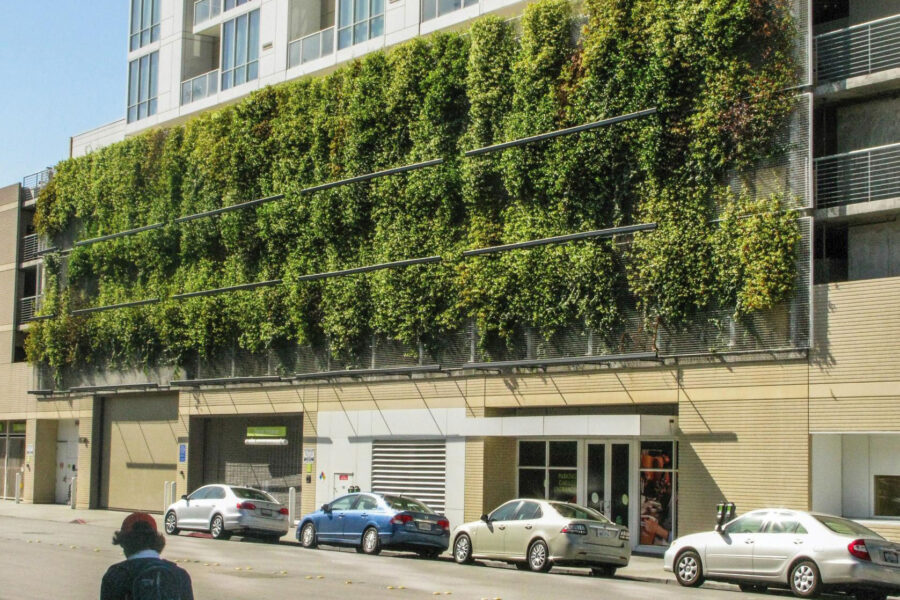
The Ellington in Oakland, California. Photo courtesy of Greenscreen
In conclusion, the design of outdoor green spaces necessitates a comprehensive understanding of various factors, including climate, plant species, irrigation systems, architectural context, and sunlight patterns—highlighting the importance of involving competent landscape architects in successful green design projects.
By carefully considering these elements, designers can ensure the resilience and longevity of green solutions while minimizing maintenance requirements. Furthermore, a thorough comprehension of plant adaptations to arid or wet conditions and their response to sunlight exposure allows for informed decisions and the selection of appropriate plant species.
Incorporating these considerations into the design will result in aesthetically pleasing and environmentally conscious outdoor spaces that benefit individuals and the planet.

